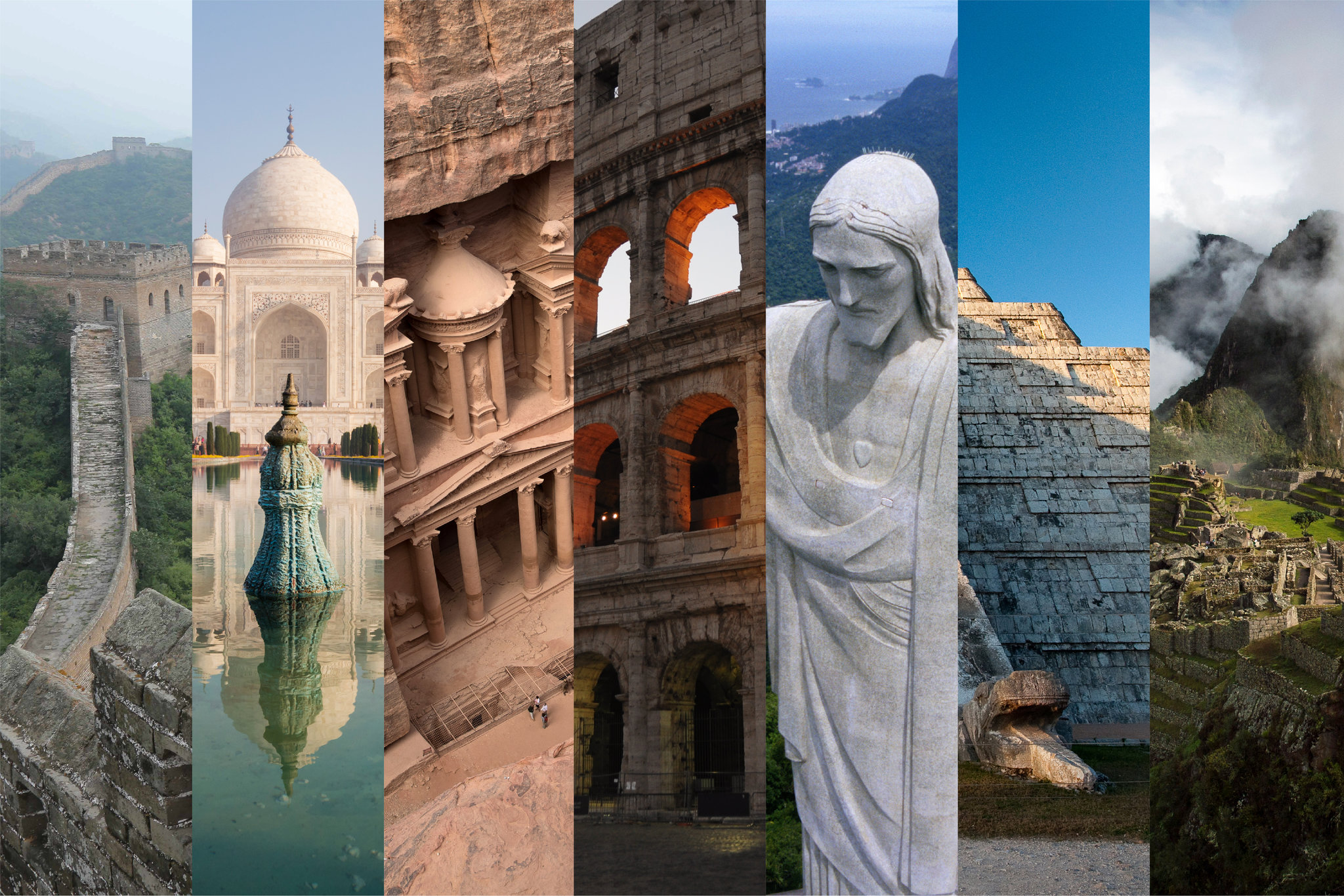Our world is filled with the most unique structures that are both man-made and natural. Some of the man-made creations include churches, tombs, temples, monuments, mosques, buildings and even cities. These structures have withstood the test of time and they continue to leave many awestruck with their brilliance. There are many in the world, but only seven are selected, which are deemed to be the best.
📍 Taj Mahal
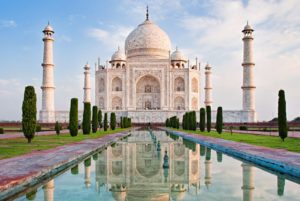
The Taj Mahal is known the world over for its beautiful architecture, history and the tale of love that led to its creation. Located in the Indian city of Agra, the Taj Mahal was commissioned in 1632 by the Mughal emperor Shah Jahan as a testament of his love for his departed wife Mumtaz Mahal.
It is considered to be the greatest architectural achievement in the whole range of Indo-Islamic architecture. Its recognized architectonic beauty has a rhythmic combination of solids and voids, concave and convex and light shadow; such as arches and domes further increases the aesthetic aspect.
The most impressive in the Taj Mahal complex next to the tomb, is the main gate which stands majestically in the center of the southern wall of the forecourt. The gate is flanked on the north front by double arcade galleries. The garden in front of the galleries is subdivided into four quarters by two main walk-ways and each quarters in turn subdivided by the narrower cross-axial walkways, on the Timurid-Persian scheme of the walled in garden. The enclosure walls on the east and west have a pavilion at the center.
📍 Colosseum
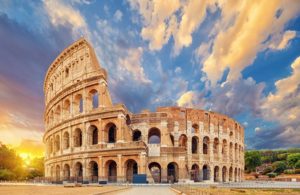
The Colosseum in Rome was built in the first century by order of the Emperor Vespasian. A feat of engineering, the amphitheater measures 620 by 513 feet (189 by 156 meters) and features a complex system of vaults. It was capable of holding 50,000 spectators, who watched a variety of events. Perhaps most notable were gladiator fights, though men battling animals was also common. In addition, water was sometimes pumped into the Colosseum for mock naval engagements. However, the belief that Christians were martyred there—namely, by being thrown to lions—is debated. According to some estimates, about 500,000 people died in the Colosseum. Additionally, so many animals were captured and then killed there that certain species reportedly became extinct.
The best way to skip the lines upon entering and to get to know the famous monument in detail, is to take a guided tour. This one, visits the Colosseum, Roman Forum, and Palatine Hill, skipping the lines and with an expert local guide.
In order to avoid endless lines that can cost you several hours, it is advisable either to arrive early in the morning or to buy an entrance ticket in the Palatine Hill, since there are usually fewer people there and the cost of entrance is combined.
Another way to avoid lines is to buy the Roma Pass, a discount card that offers free entrance to the Colosseum without having to wait in line.
📍 Machu Picchu
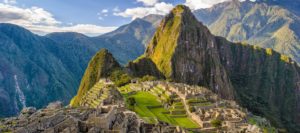
Machu Picchu, an Incan city of sparkling granite precariously perched between 2 towering Andean peaks, is thought by scholars to have been a sacred archaeological center for the nearby Incan capital of Cusco. Built at the peak of the Incan Empire in the mid-1400s, this mountain citadel was later abandoned by the Incas. The site remained unknown except to locals until 1911, when it was rediscovered by archaeologist Hiram Bingham. The site can only be reached by foot, train or helicopter; most visitors visit by train from nearby Cusco.
The high level of preservation and the general layout of the ruin are remarkable. Its southern, eastern, and western portions are surrounded by dozens of stepped agricultural terraces formerly watered by an aqueduct system. Some of those terraces were still being used by local Indians when Bingham arrived in 1911. Walkways and thousands of steps, consisting of stone blocks as well as footholds carved into underlying rock, connect the plazas, the residential areas, the terraces, the cemetery, and the major buildings. The Main Plaza, partly divided by wide terraces, is at the north-central end of the site. At the southeastern end is the only formal entrance, which leads to the Inca Trail.
📍 Christ the Redeemer

Christ the Redeemer, a colossal statue of Jesus, stands atop Mount Corcovado in Rio de Janeiro. Its origins date to just after World War I, when some Brazilians feared a “tide of godlessness.” They proposed a statue, which was ultimately designed by Heitor da Silva Costa, Carlos Oswald, and Paul Landowski. Construction began in 1926 and was completed five years later. The resulting monument stands 98 feet (30 meters) tall—not including its base, which is about 26 feet (8 meters) high—and its outstretched arms span 92 feet (28 meters). It is the largest Art Deco sculpture in the world. Christ the Redeemer is made of reinforced concrete and is covered in approximately six million tiles. Somewhat disconcertingly, the statue has often been struck by lightning, and in 2014 the tip of Jesus’s right thumb was damaged during a storm.
📍 Chichen Itza
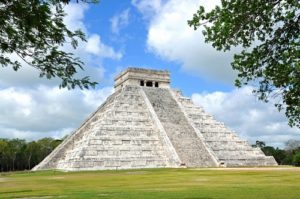
Chichén Itzá, ruined ancient Maya city occupying an area of 4 square miles (10 square km) in south-central Yucatán state, Mexico. It is thought to have been a religious, military, political, and commercial center that at its peak would have been home to 35,000 people. The site first saw settlers in 550, probably drawn there because of the easy access to water in the region via caves and sinkholes in limestone formations, known as cenotes.
The genius and adaptability of Mayan culture can be seen in the splendid ruins of Chichen Itza. This powerful city, a trading center for cloth, slaves, honey and salt, flourished from approximately 800 to 1200, and acted as the political and economic hub of the Mayan civilization. The most familiar ruin at the site is El Caracol, a sophisticated astronomical observatory.
📍 Petra
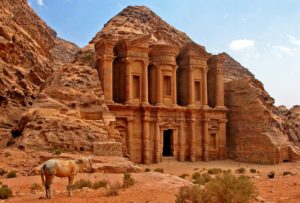
Declared a World Heritage Site in 1985, Petra was the capital of the Nabataean empire of King Aretas IV, and likely existed in its prime from 9 B.C. to A.D. 40. The members of this civilization proved to be early experts in manipulating water technology, constructing intricate tunnels and water chambers, which helped create an pseudo-oasis. A number of incredible structures carved into stone, a 4,000-seat amphitheater and the El-Deir monastery have also helped the site earn its fame.
The ancient city of Petra, Jordan, is located in a remote valley, nestled among sandstone mountains and cliffs. It was purported to be one of the places where Moses struck a rock and water gushed forth. Later the Nabataeans, an Arab tribe, made it their capital, and during this time it flourished, becoming an important trade center, especially for spices. Noted carvers, the Nabataeans chiseled dwellings, temples, and tombs into the sandstone, which changed color with the shifting sun. In addition, they constructed a water system that allowed for lush gardens and farming. At its height, Petra reportedly had a population of 30,000. The city began to decline, however, as trade routes shifted. A major earthquake in 363 CE caused more difficulty, and after another tremor hit in 551, Petra was gradually abandoned. Although rediscovered in 1912, it was largely ignored by archaeologists until the late 20th century, and many questions remain about the city.
📍 Great Wall of China
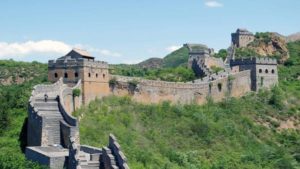
As the name suggests, it is located in China and the Great Wall is the collective name given to a series of fortification systems built across the borders of the country. The purpose of the Great Wall was to protect as well as mark the territories of the Chinese states and empires. Several of the walls were found to have been built as early as the 7th century BC, but the most well known sections were built by the Ming dynasty (1368–1644). An archaeological survey found that the entire wall with all of its branches measures out to be 21,196 km. It was designated a UNESCO World Heritage site in 1987, and attracts many visitors every year.






